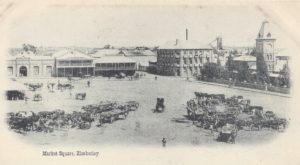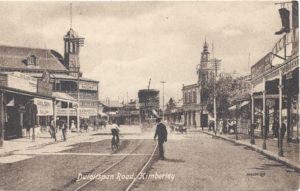1892 Kimberley South African and International Exposition
Not much remains from the Kimberley South African and International Exposition. This intercontinental exposition was held in a sparsely populated area whose remote location was not easily accessible by land or sea. The secluded location restricted means of entry and contributed to a low attendance, compared to other fairs around the same time, of 400,000 between September 8, 1892 and January 20, 1893. In 1876 Philadelphia hosted 10 million; in 1889 Paris hosted over 25 million; in 1893 Chicago hosted over 21 million; and in 1901 Buffalo hosted 8 million. De Beers Consolidated covered the £ 14,195 deficit that resulted. Created with profits in mind, the fair promoted Kimberley mining industries. De Beers' diamond mining presentation went on to be displayed at the 1893 Chicago Columbian Exposition and other fairs, promoting their system of mining and products.
The purpose of the exhibition was to stimulate trade and labor. It also served to network South African states and colonies into closer connection. The Prime Minister of Cape Colony was Sir John Cecil Rhodes. He was the richest man in South Africa due his investment in the diamond mines at Kimberley during the speculation that led to their consolidation under one management.[1] But it was Sir Henry Loch, the then Governor of the Cape of Good Hope that opened the Exposition.
The fair was held in the Kimberley Public Garden and occupied a 30-acres area.[2] The main building was constructed of corrugated iron, which set it apart from other World's Fairs during the decade from 1890-1900 which were built of stone and steel. The gardens were lit partially by lanterns and partially by electric lights. There were fireworks displays and illuminated fountains.
The rich mineral resources of South Africa were prominently displayed at the fair including gold, coal, crocidolite, silver and diamonds. The Fair presented exhibits of art, an exhibition of paintings from the royal collection of Queen Victoria and mining machinery and implements amongst other items.
There was also an archaeological exhibit from Zimbabwe [3] about the “Ruined Cities of Mashonaland” which stretched from the Shasta River to the Lundi. The emphasis was upon showing how early mining was accomplished by natives. It included five soapstone pillars, each six inches in diameter and carved with sacred birds. There were also bowls, one of which was three feet in diameter. Other bowls were were carved with human figures and cows. There were crucibles for gold melting, molds for ingots, gold burnishers, and pictures taken by Theodore and Mabel Bent from their 1891 excursion to Zimbabwe.[4]
February 22, 2018
[1] San Francisco Call Volume 74 Number 61 July 31, 1893. Spelled Zimbabye in the article.
[2] Kimberley Public Garden was later renamed Queens Park to mark the coronation of Elizabeth II.
[3] Brough, Bennett H. The Mining Industries of South Africa, As Shown at the Kimberley Exhibition. Journal of the Society Arts Volume 41 pages 166-177.
[4] Mrs. Bent's Travels. Rock Island Argus., Thursday, December 21, 1893, Page 4. https://chroniclingamerica.loc.gov/lccn/sn92053934/1893-12-21/ed-1/seq-4/

